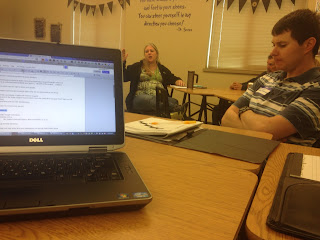 A couple weekends ago, I attended my first ever Edcamp. It was held at a local high school both in the cafeteria and a handful of classrooms. Compared to a traditional conference, there are quite a few things that were different. In an Edcamp, much of the formality of a typical conference is eliminated. Sessions are set up on the spot and are free flowing so that if you attend a presentation you are welcome to switch to a different one even right in the middle of a session.
A couple weekends ago, I attended my first ever Edcamp. It was held at a local high school both in the cafeteria and a handful of classrooms. Compared to a traditional conference, there are quite a few things that were different. In an Edcamp, much of the formality of a typical conference is eliminated. Sessions are set up on the spot and are free flowing so that if you attend a presentation you are welcome to switch to a different one even right in the middle of a session. Literally 20 minutes before the sessions begin, there are white board markers left out so that participants can write up on the window what topic the session will be about. Presenters also often act more as facilitators. The preparation can be as simple as asking the first question, (What issues are you running into with Project Based Learning in your building?), leading a discussion, all the way up to more structured presentations with slides and preparation.

I found that in the opening, there was a greater emphasis on networking at the conference as compared toa traditional conference. From the start, we were asked to write our Twitter handle on our nametag. Doing this gave me some additional Twitter follows and helped to developed a connected vibe for the presentations.
As an Edcamp newbie, I found that the conference was structured to help first timers to acclimate to the different expectations. After some meet and greet time, we met with all the other attendees to discuss how to participate in an Edcamp. They reviewed with us the free flowing expectations in a large group setting letting us know it was the norm to change sessions at will.
After participating in some sessions, I decided to throw my hat in the ring and facilitate a Edcamp session. My session topic was the concept of "App Slamming Research." I shared for about 10 minutes about the Google A Week trivia contest I run at my school and how I had added a Google Earth element to it for the Google A Week championships I hold each spring between the winners of the contest throughout the year. For my session, I tried to have a hybrid approach featuring a little more than a question to get things started, without going so far as a full blown presentation.
As I had heard, there was complete turnover in the participants. At the start, there were about 8 participants, and by the middle of the session, all 8 of the original participants had been replaced by 8 new ones.
One thing I learned from this opportunity is to have other introduce themselves at the start. This can help to guide the discussion and customize it for the audience.I also learned from this opportunity is how important it is to have some follow up questions ready. Next time, I hope to have some on hand-this will help the discussion to keep moving!
 Attending this Edcamp got me thinking about what an event like this would look like on my campus. My school has a number of very tech savvy teachers would I think would be willing to participate.
Attending this Edcamp got me thinking about what an event like this would look like on my campus. My school has a number of very tech savvy teachers would I think would be willing to participate. But what if teachers and students collaborated to show off their technology skills and facilitate sessions together? (Thanks to Stony Evans for modeling this idea) Attending this event also got me thinking about ways this event might need to be structured differently for students to experience success in it. Would students need more structure/training about how/when to leave a presentation as compared to professional educators?
Follow me on Twitter: @brian_librarian
Follow the Golden Eagle Library!
On Twitter: @Goldeneaglelmc
On Instagram: @Goldeneaglelmc


No comments:
Post a Comment